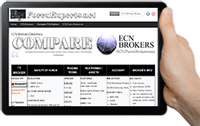(+) Liquidity Providers
🏛️ Major Liquidity Providers and Forex Brokers

Liquidity providers (LPs) are financial entities that supply retail brokers with the necessary bids and asks for their clients’ orders by acting on both sides of currency transactions. In the Forex market, the top liquidity providers are known as Tier-1 providers and typically offer the most competitive spreads.
Forex brokers connected to quality liquidity providers can offer their clients a trading environment with minimal slippage and fewer re-quotes. This is why liquidity providers play a crucial role in currency trading.
💼 Categories of Liquidity Providers and Forex Brokers
Generally, in the Foreign Exchange market, there are two levels of liquidity providers: Tier-1 and Tier-2:
(1) Tier-1
Tier-1 liquidity providers offer direct access to Foreign Exchange market liquidity. All Tier-1 providers are connected through an Electronic Communication Network (ECN).
This category mainly includes international banks such as UBS, Deutsche Bank, and Barclays. However, other Tier-1 providers include financial exchanges like CME, CBOE, LIFFE, and ICE. Some large hedge funds, brokers, and investment firms may also be classified as Tier-1 liquidity providers.
Tier-1 Liquidity and Forex Brokers:
-
ECN Forex brokers are those that can trade directly with Tier-1 liquidity.
-
DMA Forex brokers are those that can connect directly to a large Tier-1 liquidity provider.
(2) Tier-2
- Tier-2 liquidity providers act as intermediaries between Tier-1 liquidity and brokers.
- Key Tier-2 liquidity providers in the Forex market include firms such as Currenex, FXCM Pro, LMAX, and Swissquote.
Tier-2 Liquidity and Forex Brokers:
Forex brokers that do not generate enough volume to connect with Tier-1 providers connect with Tier-2 liquidity providers.
-
STP Forex brokers access Tier-2 liquidity.
-
STP stands for Straight Through Processing, while ECN stands for Electronic Communication Network.
-
Transactions of ECN/STP Forex brokers are executed directly with either Tier-1 or Tier-2 liquidity providers.
👔 Market Makers
Brokers who cannot access Tier-1 or Tier-2 liquidity are classified as Market Makers or Forex agents. These firms operate through a dealing desk (DD) and create their own market within the real market. They are often accused of having a conflict of interest with their customers because they take the opposite side of their clients’ positions. Market makers typically offer a trading environment with wider spreads and higher slippage on order execution.
- Market makers have no access to Tier-1/Tier-2 liquidity
🏦 Prime of Prime (PoP) Brokers
A Prime of Prime firm provides retail brokers with access to the trading liquidity pools of the largest banks.
- A Prime of Prime (PoP) broker can access Tier-1 banks' liquidity.
- Prime of Prime (PoP) brokers are classified as Tier-2 brokerage firms.
- PoP brokers offer higher capital leverage to their clients and allow them to trade smaller sizes compared to trading directly with a Tier-1 bank.
💱 Bridges with LPs
A Forex broker usually connects with multiple liquidity providers to take advantage of the best quotes available from various sources. This is done by establishing an electronic bridge that automatically links the broker’s trading platform with a third-party platform acting as an ECN. The Forex broker can create different client groups and decide which group's orders will be processed by the ECN and which will be filled internally.
Below is a list of some key liquidity providers worldwide, organized by region.
Table: Liquidity Providers
|
Morgan Stanley |
CME Group |
CBOE |
Citi Group |
Equinix |
JPMorgan |
CurreneX |
|
Merrill Lynch |
Goldman Sachs |
Bank of America |
Nasdaq |
Tradepoint Systems |
FXSpotStream |
EasyFX |
|
|
ICE |
NYSE |
FXDD |
Nadex |
TradAir |
GAIN Capital |
BNY Mellon |
|
|
Jefferies |
Spotex |
Global Trading Systems |
Calypso Technology |
Forexware |
|||
|
UK Clearing House |
Barclays Capital |
TP ICAP |
Make Capital |
IXO Prime |
Finalto |
LMAX |
|
iS Prime |
Refinitiv |
CMC Markets |
CrescoFX |
DMALINK |
Rayfin Solutions |
CrescoFX |
|
|
Quod Financial |
FXCM Pro |
Sucden Financial |
GMEX GROUP |
Standard Chartered |
FX Connect |
||
|
Tickmill Prime |
XTX Markets |
LSE |
|||||
|
Deutsche Bank |
Euronext |
Flow Traders |
ABN AMRO |
Luxembourg Stock Exchange |
Societe Generale |
BNP Paribas |
|
TopFx |
|||||||
|
Credit Suisse |
UBS |
Swissquote |
BierbaumPro |
SIX Swiss Exchange |
||
|
HSBC |
Global eSolutions |
Hong Kong Stock Exchange(HKEX) |
m-FINANCE |
|||
|
MUFG |
Nomura |
Tokyo Stock Exchange(TSE) |
Mizuho Bank |
|||
|
Saxo Group |
Spark Systems |
Singapore Exchange |
||||
|
The National Australia Bank (NAB) |
BAXTER-FX |
ACY Securities |
26 Degrees |
|||
|
TickTrade |
CIBC |
RBC Capital Markets |
🎯 The Importance of Market Liquidity
Liquidity is essential in any financial market. A liquid market ensures more competitive quotes and smoother transaction flows.
Low liquidity results in:
-
Wide trading spreads
-
Increased market risks
-
Sharp price fluctuations when large orders are executed
-
Reluctance of institutional investors to participate
An easy way to understand liquidity's role in the Foreign Exchange market is by comparing a major pair (e.g., GBPUSD) with an exotic pair (e.g., USDTRY). The trading spread of the exotic pair is often many times wider than that of the major pair.
💹 The Most Liquid Forex Pairs
- The most liquid Forex pair is the Euro against the US Dollar (EUR/USD). 🔗 Link: EUR/USD Stats
Its trading spreads can be as low as 0.2 pips.
- The second most liquid pair is the US Dollar against the Japanese Yen (USD/JPY). 🔗 Link: USDJPY Stats
Its trading spreads can be as low as 0.4 pips.
- The third most liquid pair is the British Pound Sterling against the US Dollar (GBP/USD). 🔗 Link: GBPUSD Stats
Its trading spreads can be as low as 0.5 pips.
Other liquid Forex pairs include the US Dollar against the Swiss Franc (USD/CHF) and the Australian Dollar against the US Dollar (AUD/USD).
🔗 Interesting Links: https://liquidityfinder.com/providers/type/broker
■ Liquidity Providers and Forex Brokers
ForexExperts.net
🔗 COMPARE BROKERS
» DIRECTORY
» TRADE SPREADS
» FOREX SCALPING
» FUNDS SAFETY
» SWAP RATES
Rating Formula Comparisons
Forex Brokers
💡 Forex Ratings
 Forex Broker Ratings Powered by the Next-Generation RatingFormula 5.0 (?)
Forex Broker Ratings Powered by the Next-Generation RatingFormula 5.0 (?)
The RatingFormula series, developed by George M. Protonotarios, is designed to bring objectivity to online corporate ratings. In the future, search engines and various applications are expected to adopt similar rating algorithms to accurately assess the true value of online corporations for users and rank them accordingly in search results.






